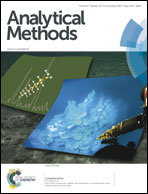Qualitative and quantitative analysis of Angelica sinensis using near infrared spectroscopy and chemometrics
Abstract
A new, rapid analytical method using near infrared spectroscopy (NIRS) was developed to differentiate Radix Angelicae sinensis samples from five different geographic origins, and to determine the contents of ethanol extract and ferulic acid in the samples. The scattering effect and baseline shift in the NIR spectra were corrected and the spectral features were enhanced by several pre-processing methods. By using principal component analysis (PCA), the grouping homogeneity and sample cluster tendency were visualized. Furthermore, random forests (RF) was applied to select the most effective wavenumber variables from the full NIR variables and to build the qualitative models. Finally, the genetic algorithm optimization combined with multiple linear regression (GA-MLR) was applied to select the most relevant variables and to build the ethanol extract and ferulic acid quantitative models. The results showed that the correlation coefficients of the models are Rtest = 0.83 for ethanol extract and Rtest = 0.81 for ferulic acid. The outcome showed that NIRS can serve as routine screening in the quality control of chinese herbal medicine.


 Please wait while we load your content...
Please wait while we load your content...